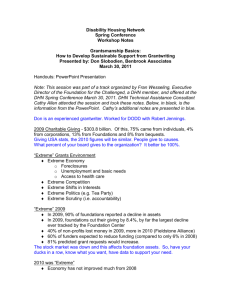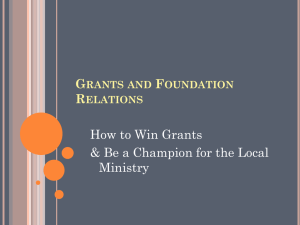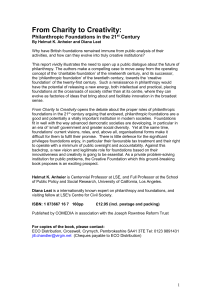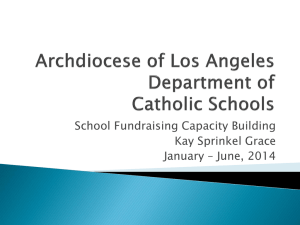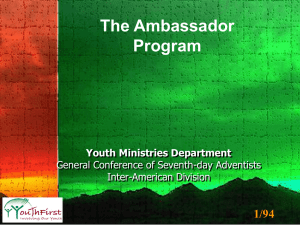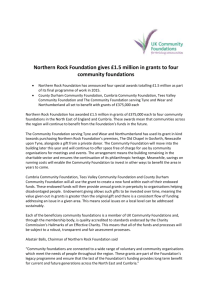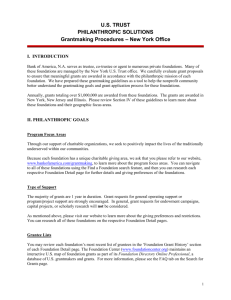Grant writing 101
advertisement
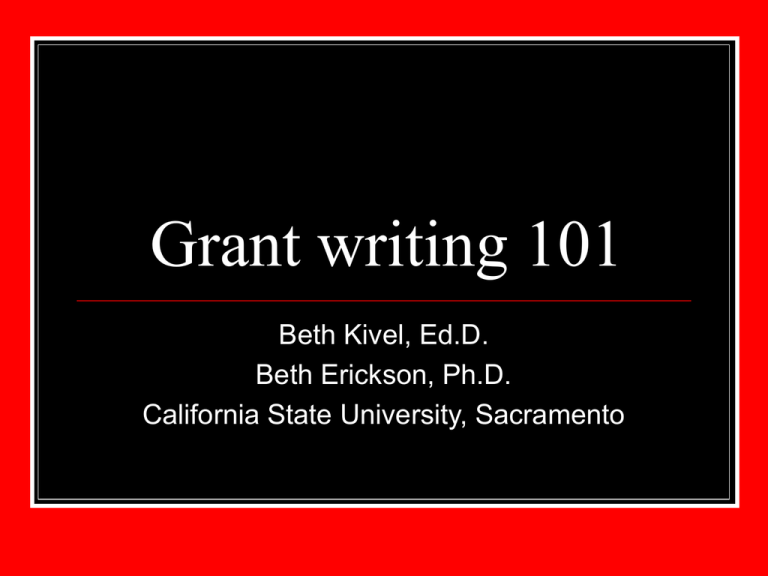
Grant writing 101 Beth Kivel, Ed.D. Beth Erickson, Ph.D. California State University, Sacramento Grantwriting – Is it art or science or both? Why write a grant? Is it really only about the money? Grantwriting as art – writing a compelling narrative to convince someone that you and/or you and your colleagues have a good idea Grantwriting as science – using data (quantitative and qualitative) to support your argument as to “why” your project should be funded Who funds grants? Foundations – 501(c)(3) organizations (tax exempt, non-profit) funding entities – Ford Foundation, Pew Charitable Trust, Rockefeller Foundation, Target, etc. Government entities – local, regional, state, federal Types of Foundations Private foundations Are supported by an individual, a group of individuals, a family, or a company. Exist for the sole purpose of making grants for charitable, educational, or religious purposes or, in some cases, of carrying out such activities themselves Corporate foundations are usually private nonoperating foundations with close ties to the corporations that provide their funding. They are often "flow through" foundations that use funds received last year to make grants this year. Philanthropic priorities are usually set by the chief executive officer of the corporation or by a committee appointed by the foundation's board of directors. Community foundations are public charities, supported by the pooled contributions of a large number of donors. Community foundations usually confine their grant-making to a specific locale, and decisions are made by trustees who represent a broad spectrum of the community's residents. (e.g., Sacramento regional community foundation) Private non-operating foundations: These are foundations that give money but don’t necessarily run programs. Finding a funder that fits Source of funding – foundation or government, you need to determine the fit by asking these three questions: Does this funding source support your project (e.g., afterschool program, sports program, etc.) Does this funding source support your population (e.g., children, seniors, people with disabilities, etc.) Does this funding source support programs in your geographic region? These three questions should help you strategically identify the best funders for your project. Some initial steps before the grantwriting process begins Gather background information and documentation in these three areas (concept, program, expenses): Concept – You have to explain how a particular project reinforces the overall direction of an organization and a funder needs to be convinced that the case for the project is compelling Program – follow this checklist Identify the nature of the project and how it will be conducted The timetable for the project The anticipated outcomes and how best to evaluate the results and Staffing and volunteer needs, including deployment of existing staff and new hires Expenses – The main financial data gathering takes place after the narrative part of the master proposal has been written. But, you should sketch out broad outlines of the budget to ensure that costs are commensurate with outcomes Overall tips Get your thoughts sorted out Develop an outline Avoid jargon Be compelling Keep it simple Keep it generic 7 parts of a successful grant 1. Executive Summary 2. Organizational Background 3. Statement of Need 4. Project Description 5. Evaluation 6. Budget and Funding Considerations 7. Cover Letter “Draft” a Master Proposal Umbrella statement of your case and summary of proposal (COMPLETED AT THE END – YOU CAN’T SUMMARIZE WHAT YOU DON’T KNOW) 1 Page Statement of Need Why this project is necessary 2 Pages Statement of need Why is this project necessary (2 pages) Usually one of the most difficult components of the grant to complete Must help funder understand “why” this issue is important Which facts or statistics best support your project More tips. . . Use anecdotes Provide real life examples Supply quotes from those who have benefited from your program Emphasize the needs of those you serve, not your own Always make the funder feel that there is hope that the problem will be solved Provide compelling “evidence” But, give the reader hope Do you want your project to be a model? Is it reasonable to portray the need as acute? Can you demonstrate that your program addresses the need differently or better than other projects that preceded it? Avoid circular reasoning by identifying the “real” problem – the absence of something isn’t necessarily a problem. But, the consequences of the absence of something can be a problem. Possible sources of data Needs assessments conducted by objective outside parties Focus groups Interviews with stakeholders Media coverage Reports from government agencies or other nonprofits Demographic studies Projections for the future about the status of things. . . Project Description Nuts and bolts of how the project will be implemented and evaluated 3 Pages Project Description Nuts and bolts of how the project will be implemented (3 pages) Usually includes: Overall project narratives and goals Objectives (how you will carry out the goals of your project?) Staffing/administration (who will run the project?) Evaluation (did you accomplish your goals and objectives?) Sustainability (how will you keep the project going once the grant money ends? Budget Financial description of the project plus explanatory notes 1 Page Organizational Background History and governing structures of the organization; the activities, customer base, and services should be outlined. 1 Page Conclusion Summary of the proposal’s main points. Package the proposal Tailor your Master Draft to the funder’s specifications Create a checklist for attachments 501(c)3 Letter Organization Budget Audited Financials List of Board of Directors List of Other Funders Suggestions Answer the questions that are asked in a succinct and concise manner. Put together a neat clean package. Edit your responses to match their criteria Don’t be shy about your needs Start small. Build your legitimacy Research Potential Funders National Foundations: www.fdncenter.org www.guidestar.org The Foundation Center (2004). The Foundation Center’s guide to proposal writing (4th ed.). New York: The Foundation Center. Community Foundations: http:www.foundations.org/communityfoundations. html Government funding opportunities www.grants.gov Local and state funding: Check your local city website for Office of Grants Planning and Management
